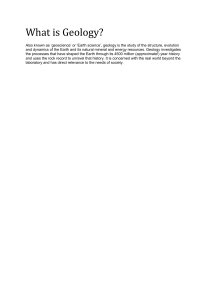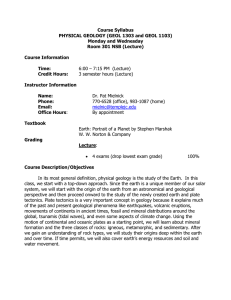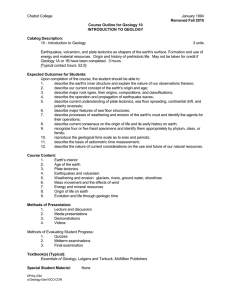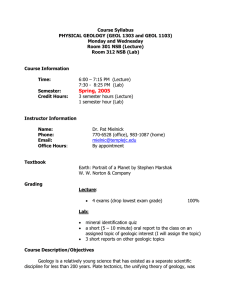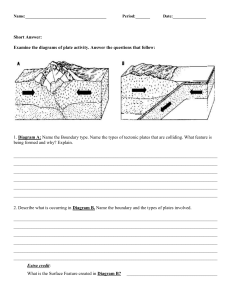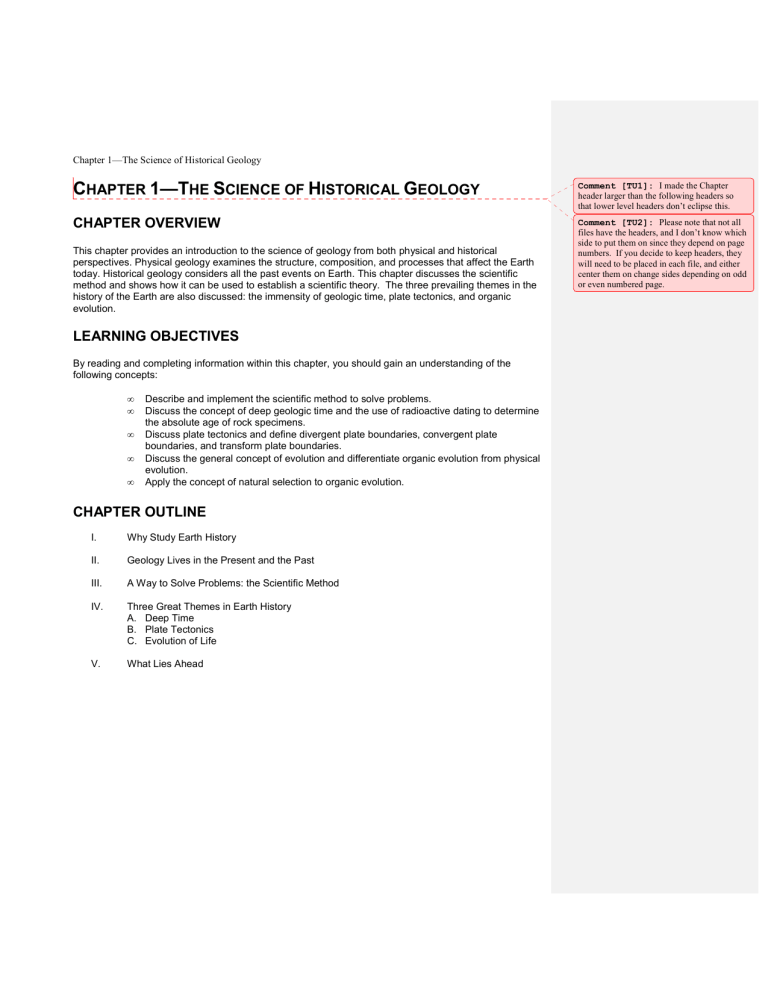
Chapter 1—The Science of Historical Geology CHAPTER 1—THE SCIENCE OF HISTORICAL GEOLOGY Comment [TU1]: I made the Chapter header larger than the following headers so that lower level headers don’t eclipse this. CHAPTER OVERVIEW Comment [TU2]: Please note that not all files have the headers, and I don’t know which side to put them on since they depend on page numbers. If you decide to keep headers, they will need to be placed in each file, and either center them on change sides depending on odd or even numbered page. This chapter provides an introduction to the science of geology from both physical and historical perspectives. Physical geology examines the structure, composition, and processes that affect the Earth today. Historical geology considers all the past events on Earth. This chapter discusses the scientific method and shows how it can be used to establish a scientific theory. The three prevailing themes in the history of the Earth are also discussed: the immensity of geologic time, plate tectonics, and organic evolution. LEARNING OBJECTIVES By reading and completing information within this chapter, you should gain an understanding of the following concepts: • • • • • Describe and implement the scientific method to solve problems. Discuss the concept of deep geologic time and the use of radioactive dating to determine the absolute age of rock specimens. Discuss plate tectonics and define divergent plate boundaries, convergent plate boundaries, and transform plate boundaries. Discuss the general concept of evolution and differentiate organic evolution from physical evolution. Apply the concept of natural selection to organic evolution. CHAPTER OUTLINE I. Why Study Earth History II. Geology Lives in the Present and the Past III. A Way to Solve Problems: the Scientific Method IV. Three Great Themes in Earth History A. Deep Time B. Plate Tectonics C. Evolution of Life V. What Lies Ahead Chapter 1—The Science of Historical Geology KEY TERMS (Pages 1–9) absolute age (7): The geologic age of a fossil, or a geologic event or structure expressed in units of time, usually years. asthenosphere (7): The zone between 50 and 250 kilometers below the surface of the Earth, where shock waves of earthquakes travel at much reduced speeds, perhaps because of less rigidity. The asthenosphere may be a zone where convective flow of material occurs. convergent boundary (7): Develop when two plates move toward one another and collide. Characterized by a high frequency of earthquakes and are thought to be the zones along which folded mountain ranges or deep-sea trenches may develop. crust (7): The outer part of the lithosphere; it averages about 32 kilometers in thickness. Seismically defined as all of the solid Earth above the Mohorovicic discontinuity. The thin, rocky veneer that constitutes the continents and the floors of the oceans. divergent boundary (7): Develop when two plates move way from each other. May manifest themselves as mid-oceanic ridges complete with tensional (pull-apart) geologic structures. The rending of the crust is accompanied by earthquakes and enormous outpourings of volcanic materials that are piled high to produce the ridges itself. half-life (7): The time needed for half of the original quantity of radioactive atoms to decay to daughter products. historical geology (2): A branch of geology concerned with the systematic study of bedded rocks and their relations in time and the study of fossils and their locations in a sequence of bedded rocks. hypothesis (4): An explanation for an observation. It is subject to testing and modification. If well supported by evidence, it then may become a theory. lithosphere (7): The outer shell of the Earth, lying above the asthenosphere and comprising the crust and upper mantle. mantle (7): A thick, homogeneous layer surrounding the core composed of several concentric layers. Believed to have stony, rather than metallic, composition. Oxygen and silicon probably predominate and are accompanied by iron and magnesium as the most abundant metallic ions. Probably composed of peridotite, an iron- and magnesium-rich rock. natural selection (8): The natural process where by organisms are preserved or eliminated according to their fitness or adaptation to their environment. physical geology (2): That branch of geology concerned with understanding the composition of the Earth and the physical changes occurring in it, based on the study of rocks, minerals, and sediments, their structures and formations, and their processes of origin and alteration. plate tectonics (7): The theory that explains the tectonic behavior of the crust of the Earth in terms of several moving plates that are formed by volcanic activity at oceanic ridges and destroyed along great ocean trenches. relative age (7): The placing of an event in a time sequence without regard to the absolute age in years. scientific law (4): If a theory continues to triumph over every challenge, it can be raised to the level of a scientific law. scientific method (4): A systematic way to find answers to questions, solutions to problems, and evidence to prove or disprove ideas and beliefs. Comment [TU3]: Are page numbers verified to new text? Chapter 1—The Science of Historical Geology theory (4): A hypothesis that survives repeated challenges and is supported by accumulating favorable evidence. transform boundary (7): A plate boundary along which plates slide past one another, and the crust is neither produced or destroyed. On land it is recognized as a strike-slip fault. Chapter 1—The Science of Historical Geology MULTIPLE-CHOICE QUESTIONS c 1. a 2. To discover how the Earth was formed, geologists identify the minerals in a. meteorites. c. rock strata in various locations on Earth. b. lunar samples. d. rocks extruded in volcanic eruptions. d 3. The species of primates that evolved on the Earth between 300,000 and 150,000 years ago is a. homo erectus. c. Cro-Maguous. b. Neanderthals. d. homo sapien. The Earth’s age is approximately a. 300,000 years. b. 4,600,000 years. c. 4,600,000,000 years. d. 5,500,000,000 years. c 4. The study of the Earth’s origin and evolution, changes in the distribution of lands and seas, the growth and reduction of mountains, and the succession of animals and plants is called a. Earth science. c. historical geology. b. physical geology. d. geological science. b 5. To a scientist, knowledge that has a very high probability of being correct is called a. data. c. hypothesis. b. theory. d. law. a 6. Humans have penetrated and explored the deep interior of Antarctica for only the last ___________ years. a. 100 c. 10,000 b. 1,000 d. 100,000 7. The study of the Earth’s materials (rocks and minerals) and the varied processes that occur both on the surface and deep in the interior of the Earth is called a. earth science. c. historical geology. b. physical geology. d. geological sciences. 8. The systematic way to find answers to questions, solutions to problems, and evidence to prove or disprove ideas and beliefs is called a. hypothesis. c. theory. b. law. d. scientific mether b d a 9. c 10. The rigid outer layer of the Earth, which is roughly 100 kilometers, thick is called the a. asthenosphere. c. lithosphere. b. atmosphere cover. d. hydrosphere. b 11. The time required for one half the original quantity of radioactive atoms to decay is called a. atomic mass time. c. decomposition time. b. half-life. d. degradation time. d 12. The rock age that is based on whether particular layers or bodies are older or younger than others is called a. absolute age. c. real age. b. comparative age. d. relative age. a 13. The plastic, easily deformed layer of the Earth that the plates rest on is called the a. aslhthosphere. c. lithosphere. b. atmosphere cover. d. hydrosphere. Comment [TU4]: Cro-Magnon? Comment [TU5]: Do you mean scientific method? The actual age of a rock in years is also called the a. absolute age. c. real age. b. comparative age. d. relative age. Comment [TU6]: Correct spelling? Chapter 1—The Science of Historical Geology c 14. The crust and the mantle of the Earth make up the a. asthenosphere. c. lithosphere. b. atmosphere cover. d. hydrosphere. b 15. The boundary that is formed where two or more plates move apart from one another is called a. convergent boundary. c. joint boundary. b. divergent boundary. d. transform boundary. a 16. The great unifying theory of biology is a. evolution. b. natural selection. a b a c c. meiosis. d. inheritance. 17. The boundary that is formed when two or more plates move toward one another is called a. convergent boundary. c. joint boundary. b. divergent boundary. d. transform boundary. 18. The great unifying theory in geology is a. the Big Bang theory. b. plate tectonics. c. continental drift. d. rock cycle. Gravity is an example of a/an a. law. b. theory. c. principle. d. hypothesis. 19. 20. The oldest rocks found on the Earth were located in a. the Himalayas. c. the Canadian Rockies. b. the Alps. d. the Appalachians. Chapter 1—The Science of Historical Geology FILL IN THE BLANK 1. The Earth was formed ________________ years ago. 2. ______________ geology addresses the Earth’s origin and evolution, changes in the distribution of lands and seas, the growth and reduction of mountains, and the succession of animals and plants through time. 3. The _______________ ________________ is a systematic way to find answers to questions, solutions to problems, and evidence to prove or disprove ideas and beliefs. 4. A ________________ fits all the data in a scientific investigation and is likely to account for observation and is likely to account for observations in the future as well as the future. 5. To a scientist, a ______________ represents knowledge that has a very high probability of being correct. 6. ______________________ is the time required for one half of the original quantity of radioactive atoms to decay. 7. Determining the ___________________ age of a rock is based on whether particular layers or bodies are older or younger than others. 8. The “great unifying theory” in geology is _____________ ________________. 9. This rigid outer layer of the Earth (approximately 100 kilometers thick) includes the crust as well as the uppermost part of the mantle. _________________________ 10. The outermost part of the lithosphere that is about 32 kilometers thick is called _______________. 11. The zone within the Earth between 50 and 250 kilometers thick and is thought to be a zone where the conventive flow of material occurs is called the ____________________. 12. Charles Darwin’s proposed theory that any given species produces more organisms than can survive to maturity is part of his theory of _______________ ________________. 13. Distinctive shells of these invertebrates have been widely used to identify rock formation when drilling for oil or gas. __________________ 14. Where two or more plates move apart from one another, the plate margins form _____________ boundaries. 15. When plates grind past one another ________________ boundaries occur. Chapter 1—The Science of Historical Geology TRUE/FALSE 1. Geology is the study of Earth and does not include the study of any other planet. 2. The statement “the Mediterranean Sea was once a desert” is an example of a hypothesis. 3. The asthenosphere is closer to the surface of the Earth than the lithosphere. 4. There is conclusive evidence that the Mediterranean Sea was once a desert. 5. The discovery of radioactivity enabled geologists to find the absolute age of rocks. 6. Charles Darwin was the first individual to propose the theory of evolution. 7. The Earth is a relativity static ball of rock that is orbiting the sun. 8. Geology is an eclectic science drawing principles from many areas. 9. Data collection is the first step in the scientific method. 10. A geologic time scale was developed using relative time dating. Chapter 1—The Science of Historical Geology ANSWER KEY Multiple Choice Fill Ins True/False 1. 2. 3. 4. 5. 6. 7. 8. 9. 10. 11. 12. 13. 14. 15. 16. 17. 18. 19. 20. 1. 2. 3. 4. 5. 6. 7. 8. 9. 10. 11. 12. 13. 14. 15. 1. 2. 3. 4. 5. 6. 7. 8. 9. 10. c a d c b a b d a c b d a c b a a b a c 4.6 billion Historical scientific method hypothesis theory Half-life relative plate tectonics lithosphere crust asthenosphere natural selection foraminifera divergent transform F T F T T F F T T T Chapter 1—The Science of Historical Geology RESPONSES TO QUESTIONS ACCOMPANYING SELECTED FIGURES No questions on figures for this chapter.

